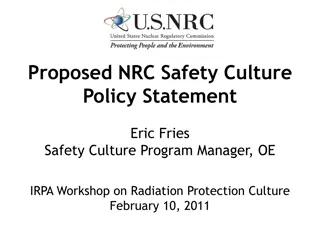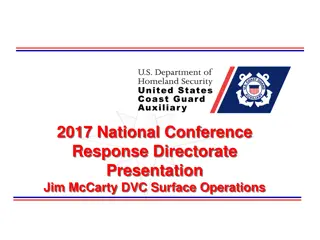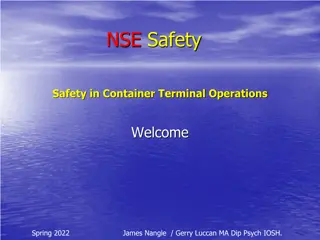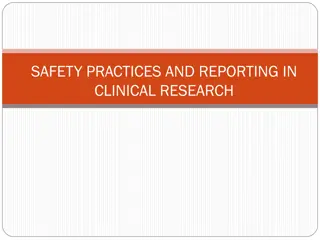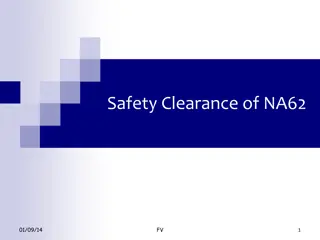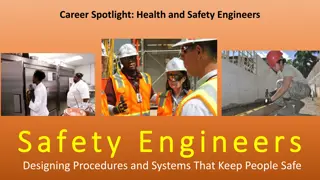
Importance of Health and Safety in the Workplace
Learn about the Occupational Health and Safety Act of Ontario and why health and safety is crucial for all employees. Understand the duties and responsibilities of employers, supervisors, and employees to ensure a safe work environment. Discover the three rights of employees regarding workplace hazards.
Download Presentation

Please find below an Image/Link to download the presentation.
The content on the website is provided AS IS for your information and personal use only. It may not be sold, licensed, or shared on other websites without obtaining consent from the author. If you encounter any issues during the download, it is possible that the publisher has removed the file from their server.
You are allowed to download the files provided on this website for personal or commercial use, subject to the condition that they are used lawfully. All files are the property of their respective owners.
The content on the website is provided AS IS for your information and personal use only. It may not be sold, licensed, or shared on other websites without obtaining consent from the author.
E N D
Presentation Transcript
HEALTH & SAFETY August 2018
Health & Safety Important for All Employees OH&SA: Ontario's cornerstone legislation for workplace health and safety. The goal of our Health & Safety program is to prevent occupational injury and disease health & safety is everyone s responsibility.
The Occupational Health and Safety Act of Ontario (The Green Book) Consolidated Edition
Health & Safety Important for All Employees The Ministry of Labour (MOL) recommends that employers and employees work in partnership to promote and improve health and safety within an organization. Three pillars for internal processes: 1) Enforcement 2) Compliance 3) Partnership Everyone has a responsibility in securing that message and Everyone has a responsibility in securing that message and commitment. commitment.
OH&SA and the Education Act OH&SA Section 2(2): Despite anything in any general or special Act, the provisions of this Act and the regulations prevail. This means that the Occupational Health & Safety Act supersedes all other Acts respecting safety of workers, including the Education Act; however, we must comply with both Acts to ensure the safety of our students. 55
Duties and Responsibilities - Employer Take all responsible precautions for the protection of employees. Provide information, instruction and supervisor for the protection of employees. Ensure that all supervisors have working knowledge of the Act and Regulations.
Duties and Responsibilities Supervisors/Administrators Ensure that employees comply with the Act and Regulations. Take all precautions reasonable in the circumstance for the protection of employees. The supervisor is responsible to ensure that an employee follows all safety procedures. Investigate all accidents and submit the Incident Report Form within 24 hours.
Three Rights of Employees 1. 1. The The Right to Right to Know Physical Physical Hazards Hazards Electricity High exposure to sunlight/uv rays/heat or cold Liquids/spills on the floor Know Constant loud noise Ladders and scaffolds Unsecured objects such as filing cabinets Biological Biological Hazards Hazards - - Blood and body fluids; Bacteria and viruses Chemical Chemical Hazards Liquids like cleaning products, paint, acids and solvents Gases like acetylene, propane, carbon monoxide and helium Hazards Ergonomic Ergonomic Hazards Poor lighting; poor workstations and chairs; Improper lifting technique; repeating the same movements over and over Hazards
Three Rights of Employees 1. 1. The The Right to Right to Know Know (e.g. Specific Hazards) (e.g. Specific Hazards) As identified in Major Risk Assessment As identified in Major Risk Assessment Slips/trips/falls may cause sprains/strains or fractures Exposure to body fluids e.g. HIV/Viruses/Hepatitis C Ergonomics/improper lifting may cause strains/sprains Fire Emergency (burns/asphyxiation) Asbestos Exposure (asbestosis)
Three Rights of Employees 1. 1. The The Right to Right to Know Know As identified in Major Risk As identified in Major Risk Assessment, Assessment, continued continued Chemical Exposure (burns, inhalation, irritated eyes, etc.) Controlled Energy Source (electrical shock) Yard duty (exposure to sun, ground condition may lead to trips and falls) Workplace Violence (student, stranger) Ergonomic hazards (strains/Repetitive Strain Injuries/eye fatigue)
Three Rights of Employees 2. 2. The The Right to Right to Refuse Refuse Employees have the right to refuse work that they believe is unsafe and unhealthy. Speak with your supervisor, who will investigate to determine whether danger exists. Locate our Work Refusal Reporting Form on Intranet, under Health & Safety forms
Three Rights of Employees 3. 3. The The Right to Participate Right to Participate Employees can participate in the Joint Health and Safety Committee (JHSC) current members of JHSC: Aaron Barry Principal Joe Snofl Occasional teacher Krystal Rewega Secondary teacher Marc Boisvert Custodial Cheryl Ann Corallo Superintendent of Business Catia Temelini Communicative Disorders Assistant (CDA) Lucie Cullen - Principal Danny Blake Custodial James Morgan Facilities Administrator Maurice Martin Elementary teacher Alan Levesque Facilities Manager
Duties and Responsibilities Employee Work in compliance of the Act and Regulations. Use or wear any equipment or safety devices as provided by the employer, and follow all safety procedures as directed by your supervisor or the training provided. Report to your supervisor/administrator all safety defects in equipment, missing protective devices or hazards. Report to your supervisor any known violation of the Act and Regulations.
Duties and Responsibilities Employee Do not remove or make ineffective any required protective devices as required for performing the duties of your job. Do not use unsafe equipment or work in such a way that would endanger yourself or others.
Examples of what this means Employees should wear appropriate footwear for your working conditions. Refer to APG#HS09 Footwear Safety for more details. Utilize your professional judgement and choose appropriate footwear to meet the needs related to your duties. Check with your supervisor when unsure and request a recommendation. (e.g. field trips). Be aware of surroundings and conditions that may dictate the use of appropriate footwear. Ensure that footwear is in good condition. Report potentially hazardous conditions that could contribute to a slip/trip or fall to your supervisor.
Examples of what this means Employees should use a proper step ladder and never stand on a table, desk, or chair. Employees must ensure they have proper safe electrical equipment (all plugs have grounds, extension cords are CSA approved and not frayed).
Be Aware Of The safety of the other workers. Remind them and help them to be safe. (Get the step ladder for someone and help carry it if necessary ...) Health & Safety includes the Building Code and Fire Code. (Keep all materials {especially combustible} off the heating vents, do not hang things from ceiling, do not pile boxes to the point where they become unmanageable and dangerous to move, etc.) Report unsafe situations to your administrator/supervisor and record incidents of violence and harassment.
Workplace Accidents and Injuries Definition of a workplace accident or injury as defined by WSIB: a wilful and intentional act, not being the act of the worker a chance event occasioned by a physical or natural cause, and disablement arising out of and in the course of employment Reporting Workplace Accidents: Workplace accidents/injuries must be reported to your supervisor and to Human Resource Services if the worker Seeks medical attention from a health care practitioner and/or Incurs an absence from work (referred to as a lost time injury) Complete an Accident Report Form to report accident. Ask your supervisor for the form. The form is also located on the intranet under Health and Safety forms.
Workplace Hazardous Materials Information Systems (WHMIS) All hazardous materials used in the workplace, (e.g. schools, departments) must be properly labeled.
Material Safety Data Sheets (MSDS) For employees using hazardous materials MSDS Sheets are located on the Board s website under the For Staff tab. Please see Resources in the column on your right. Please click on CCOHS Material Safety Data Sheets CCOHS Material Safety Data Sheets REMINDER REMINDER: Do not bring products (i.e., cleaning or chemical) from home to school
Universal Precautions Five Steps of Universal Precautions: Education Hand Washing Wearing Protective Barriers Cleaning Contaminated Surfaces Disposal of Contaminated Articles
Workplace Safety Inspections APG HS03 Inspections are a proactive means of preventing accidents Inspections are a proactive means of preventing accidents All employees are responsible for: All employees are responsible for: 1. 1. Conducting pre Conducting pre- -use inspections of equipment, materials use inspections of equipment, materials and operating procedures and operating procedures 2. 2. Reporting to their supervisor any unsafe acts or Reporting to their supervisor any unsafe acts or conditions conditions 3. 3. Providing info during a regulated inspections regarding Providing info during a regulated inspections regarding any h & s concern in workplace any h & s concern in workplace Formal workplace inspections are conducted by the worker Formal workplace inspections are conducted by the worker rep on the JHSC or by an Alternate Member. rep on the JHSC or by an Alternate Member.
Health & Safety Information First Aid training At least one school secretary per school, all principals, all vice-principals, and all Assistant Custodians, Custodians, and BSTs are trained in First Aid Fire Prevention Upon Discovery of Fire: Call 9-1-1 Sound fire alarm Close doors Leave fire area immediately Leave building via nearest exit Do not use elevator
Emergency Procedures Anyone working within the school should be prepared for Anyone working within the school should be prepared for emergencies emergencies. All schools will have emergency binders. . All schools will have emergency binders. Please see your principal and/or supervisor for further Please see your principal and/or supervisor for further instructions/directions and for the location of worksite instructions/directions and for the location of worksite specific information. specific information. Ensure you are aware Ensure you are aware of the following: - Location of emergency exits - Fire/lockdown and any other emergency procedures - necessary steps to take in an emergency situation of the following:
Emergency Contact Numbers Life Threatening Emergency Situation 9-1-1 Poison Information 1-800-268-9017 Telehealth Ontario 1-866-797-0000


